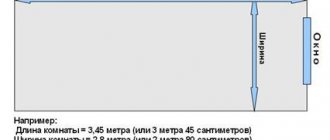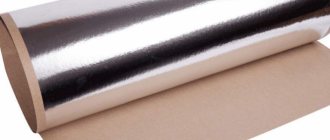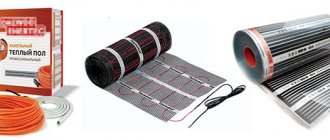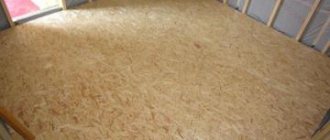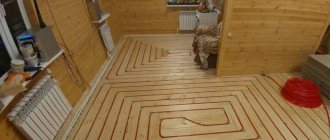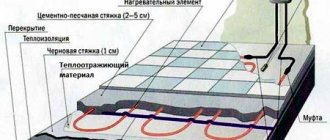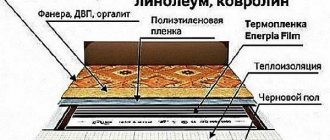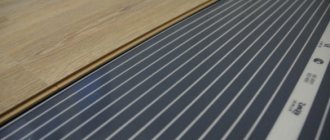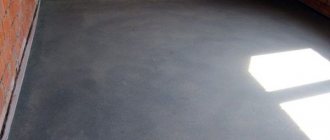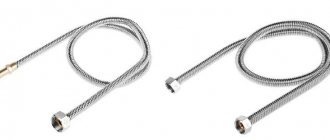One of the most important stages in the process of installing a heated floor system is the laying of thermal insulation material, which ensures uniform consumption of thermal energy and maintenance of optimal microclimatic parameters in the living room. The thermal insulation layer serves as an obstacle to the path of thermal energy and prevents it from escaping through the base on which it is laid. The most popular, due to its performance properties, is polystyrene foam for heated floors.
Expanded polystyrene for heated floors
Expanded polystyrene for heated floors - how to choose, where installation is allowed and how to install
An important element when installing heated floors is the thermal insulation material.
Heat consumption and maintaining an optimal atmosphere in the room depend on it. Lack of thermal insulation will lead to the formation of condensation, and this in turn will lead to dampness and mold. In addition, without this gasket, some of the heat will go down, thereby being wasted.
The most popular and modern thermal insulation product for heating systems is polystyrene foam.
Pros of reflective insulation
- Reasonable price with fairly high quality material;
- Easy to use. Installation does not require special skills or expensive tools;
- Compactness and elasticity of the material. Due to its compactness, it can be used in many different areas. And due to its elasticity, installation work in hard-to-reach places is simplified;
- Good hydro- and vapor barrier properties;
- Good noise absorption. We all like silence in the house; almost all types of reflective thermal insulation perfectly block out the majority of sounds from outside;
- Environmental friendliness. Does not cause harm to health, as it is made from safe materials;
- Fire resistance. All reflective insulators are made from fire-resistant materials;
- Durability. These materials do not rot, due to which they retain almost all of their heat-insulating properties for a very long time.
What is expanded polystyrene
Expanded polystyrene is a foamed polymer substance. It is produced by foaming the mass by adding a low-boiling liquid to it. As a result, granules with a waterproof shell are formed.
Then, they are exposed to hot steam, which leads to their increase in size up to 30 times. The granules, connecting with each other, form polystyrene foam boards having a high density. This product is unique because, despite its lightness and airiness, it can withstand pressure and compression.
German scientists managed to obtain this material in the 20th century, as a result of the synthesis of styrene, a chemical substance that was released when Styrax resin was heated.
Polystyrene concrete
Due to its low weight, polystyrene concrete does not place a large load on the floors, unlike traditional liquid screed. It does not require waterproofing or additional insulation. You can lay tiles or laminate on a thick backing directly on top of polystyrene concrete. To lay soft coverings such as carpet or linoleum, a thin layer of traditional screed, no more than 30 mm thick, is poured over the insulation.
Polystyrene concrete floors are being poured
| General characteristics of polystyrene concrete | Values |
| Flammability group | G1 |
| Density | from 150 to 600 kg/m³ |
| Frost resistance | from F35 to F300 |
| Strength characteristics | from M2 to B2.5 |
| Coefficient of thermal conductivity | ranging from 0.055 to 0.145 W/m °C |
| Vapor permeability of polystyrene concrete | 0.05 mg/(m h Pa) |
Parameters for choosing insulation, what we pay attention to
When purchasing floor heating from expanded polystyrene, you should take into account indicators such as: quality and variety.
Initially, the quality of polystyrene foam boards for heated floors is determined by their appearance. The following points should be taken into account:
For your information! Experts recommend especially inspecting the place of the cut or break. If the granules are intact in this area, we can talk about their poor adhesion to each other. In a high-quality slab, when broken, the granules should also be destroyed.
Screed reinforcement
- The reinforcing mesh in the construction of a wet heated floor is laid on top of the insulation layer. The grid performs the following functions:
- perceives tensile forces when the heated floor slab bends;
- blocks channels in the insulation layer when pipelines of other systems (radiator heating, water supply, sewerage) are laid in the floor structure ( Fig. 18
); - is a convenient frame for fastening underfloor heating pipes.
Rice. 19. Laying pipelines of other engineering systems in the heated floor structure: 1 – radiator heating pipes; 2 – floor slab; 3 – layer of insulation (expanded polystyrene); 4 – heated floor pipes; 5 – screed; 6 – reinforcing mesh.
A number of imported manufacturers supply special galvanized mesh for underfloor heating with mesh sizes of 150 x 150 mm. In domestic construction practice, masonry mesh made of reinforcing wire ВрI Ø 5 mm with a mesh pitch of 50 x 50 mm is more often used.
Analogs of expanded polystyrene
There are a number of materials that can also be used as thermal insulation, but their characteristics are significantly inferior to expanded polystyrene.
Good to know! Despite the claims of manufacturers, polystyrene foam, especially when installing a heated water floor, requires good waterproofing. Otherwise, the degree of thermal insulation will significantly decrease under the influence of moisture.
The quality of expanded polystyrene is influenced by production technology; various characteristics of the material and laying features depend on it. Several types of polystyrene are available.
Profile (expanded polystyrene mats)
Expanded polystyrene slabs, which were developed specifically for these systems, have gained particular popularity when installing heated floors. The main advantage of the mats is the special bosses located on their surface; they significantly simplify the installation of heating elements, since no additional parts are required for their fastening.
The positive aspects of such plates:
Foil polystyrene
Expanded polystyrene with a foil layer is primarily intended for heated floors. Reflective foil helps to heat the room more efficiently, as heat is transferred evenly from the floor surface upward.
When installing a heated water floor, polystyrene foam must have a foil layer. The installation process will be facilitated by the use of foil polystyrene.
Advantages of this product:
Important! This material is contraindicated when installing infrared heated floors.
Unpressed
Unpressed polystyrene foam is made by molding a composition that is pre-dried and foamed at +80 degrees.
This is the cheapest material and is also the most fragile.
Source
What is the thickness of penoplex for insulating a loggia? insulation technology
This material is foamed polystyrene in slabs, which is created by extrusion. It is ideal if you need to carry out high-quality and proper insulation of the loggia with penoplex foam, which involves doing all the steps yourself. In this case, its excellent insulating characteristics and comparative simplicity of installation operations will be useful.
What you will need to purchase for do-it-yourself thermal insulation of a loggia
Here is a list of consumables that will be needed for the work:
- Polystyrene in Penoplex boards. The main insulation layer will be created from it.
- Drywall forms an outer, smooth surface. It is also permissible to use gypsum fiber or glass magnesite analogues. Any sheet options should be selected to ensure good moisture resistance.
- Ready-made dry construction mixture for leveling the floor.
- Vapor barrier film with a foil layer.
- Construction foam. It is recommended to purchase only a product that does not contain toluene.
- Guides (slats) and fastening (screws) elements.
Do-it-yourself technology for insulating a loggia with penoplex
In each specific case, the set of techniques will be different. You will have to take into account certain decorative options and structural features. But the following algorithm can be used as an example, with necessary modifications:
- All outer layers of the floor and walls are removed.
- Window blocks are being installed. All joints are sealed with construction foam.
- Using dowels and plastic disc-shaped attachments, penoplex is attached to the walls and ceiling. Large joints are filled with construction foam. The gaps between the plates are sealed with high-quality tape.
- A vapor barrier film is attached to them with the foil side facing the inside of the room. For this operation, it is necessary to use a polyurethane-based adhesive that is not capable of damaging the penoplex. The joints between these elements are closed with metallized tape.
- A screed for a loggia can be created from a dry mixture with a thickness of 4-5 cm. It is necessary to leave a technological gap of 0.8-1 cm between it and the walls. This is necessary to prevent cracks from appearing when temperature fluctuates.
- Wooden beams are installed on the vapor barrier film and attached to the main part of the wall. They are “sewn up” with drywall.
As it is not difficult to see, all of the above operations can be done by anyone with their own hands. To eliminate possible mistakes due to lack of previous experience, the following recommendations should be used:
- Various heating and lighting devices and communications equipment can be installed on the loggia. The corresponding utility networks are installed before finishing work is carried out.
- There is no need to create a vapor barrier layer between the penoplex and the main wall. This solution will stimulate the accumulation of condensation in the corresponding hidden area.
- If wooden slats or other sheathing elements are hidden in the thickness of the insulating layer, this will impair its effectiveness.
- For such frames there is no need to use metal guides. Such options will create favorable conditions for the penetration of cold into the premises.
How to calculate the thickness of penoplex slabs
You can do a variety of jobs with your own hands. You can also independently calculate the thickness of the foam insulation layer. To make the calculations more specific, we will make the following assumptions:
- Building location: Moscow. According to current standards for this city, the thermal resistance coefficient of walls in a residential building must be at least 3.14 square meters. on gr. Celsius/W
- Main wall: two bricks. Its heat transfer resistance will be 0.99 sq. m. on gr. Celsius/W
Thus, for these climatic conditions it is necessary to improve the existing insulation indicators by the following amount: 3.14-0.99 = 2.15 sq. m. on gr. Celsius/W With a thermal conductivity coefficient of penoplex of 0.028, the following final thickness of the slab will be required: (2.15*0.028)*100=6.02 cm.
If it is inconvenient to make calculations with your own hands, or there is not enough initial data, then you can use special programs, “calculators”. They are posted on specialized websites of penoplex sellers.
What kind of base can it be laid on?
Expanded polystyrene is a foamed polymer substance, which during the manufacturing process is exposed to hot steam, followed by filling the voids with gas. The modern variety of expanded polystyrene was obtained in the mid-20th century by German specialists as a result of the synthesis of styrene, a chemical compound obtained after heating the resin of the Styrax plant or balsam tree, known to the ancient Egyptians.
The shade of insulation boards does not affect their performance characteristics
In addition to its widespread use in a wide variety of industries and construction, this material is used in the installation of warm water or electric floors.
Now there are several types of “warm floors” on the construction market. They differ in the type of coolant and operating efficiency. How to choose a heated floor? We'll tell you in our article.
"Pie" of a warm electric floor
Important! Installing coolant pipes directly on the base, without an insulating layer, will lead to the fact that a significant amount of heat will tend to heat the base, and not the room. And this is not the worst thing - the effect of warm air on a poorly ventilated space under the ceiling provokes the formation of condensation and, as a result, the creation of favorable conditions for harmful microorganisms, which not only destroy those acting on the foundation material, but also create a direct threat to the health of the residents of the house.
Expanded polystyrene board with marked foil layer
Expanded polystyrene is one of the available types of heat-insulating materials that allow you to organize the correct operation of the “warm floor” system. The basis for its installation are bases of different types:
Important! To waterproof the base under polystyrene foam, you cannot use solvent-based compounds and bitumen mastic, since the structure of the insulation begins to collapse under their influence.
Table 1. Laying heated floors on a wooden base
| Image | Description |
| The heated floor is laid on plank flooring. | |
| The boardwalk is treated with an antiseptic composition. | |
| To work, you will need a polystyrene foam relief mat and a foam polystyrene damper tape with an adhesive layer. | |
| The tape is fixed at the end of the mat, with which it will be adjacent to the wall. | |
| The tape is fixed around the perimeter of the room. | |
| If necessary, trim the mat using a construction or stationery knife. | |
| Heat distribution plates are inserted into the gaps between the protruding elements of the polystyrene foam mat, into which the coolant pipe will subsequently be laid. The plates provide rigid fixation of the coolant and promote uniform distribution of heat flow. | |
| In places where the pipe will turn, leave enough space to create the required radius. | |
| The pipe is being laid. | |
| On top of the laid coolant, a flooring is formed under the finishing material using gypsum fiber sheets, laid in two layers with offset and fixed with self-tapping screws. |
Arrangement of edge zones
In cases where underfloor heating cannot completely compensate for the heat loss of the room, you can try to compensate for the lack of thermal energy by installing edge zones. Edge zones are areas of heated floors with an increased temperature of the floor surface, which are usually installed along external walls to a width of no more than 1 m.
- The specific heat flux in the edge zones can be increased in several ways:
- reduce the pipe pitch ( Table 4
;
Fig. 5 A
); - use a separate loop with an increased coolant temperature ( Fig. 5 B
); - use a separate loop with an increased pipe diameter ( Table 5
); - use a separate loop with an increased coolant temperature, reduced pitch and increased pipe diameter.
Table 4. Effect of pipe pitch on the change in specific heat flux (relative to a pitch of 15 cm)
| Pipe pitch, cm | 7,5 | 10 | 15 | 20 | 25 | 30 |
| Change in specific heat flow, all other things being equal, % | +13 | +8 | 0 | –8 | –15 | –22 |
Table 5. Influence of pipe diameter on the change in specific heat flow (relative to the outer diameter of 16 mm)
| Pipe outer diameter, mm | 12 | 16 | 20 | 25 |
| Change in specific heat flow, all other things being equal, % | 9 | 0 | +10 | +25 |
The use of separate loops with increased coolant temperature makes sense when there are several rooms with edge zones. In this case, the pipelines of the edge zones can be served by a separate pumping and mixing unit.
In any case, the temperature of the floor surface in the edge zones should not exceed 31 ° C, as well as the temperature for which the finishing floor covering is designed.
Rice. 5. Options for installing edge zones of heated floors
Characteristics of expanded polystyrene
Foamed polystyrene foam looks more advantageous compared to other thermal insulation materials, due to the fact that it allows you to get a fairly dense, durable and rigid base. During its production, the initial mass is foamed by introducing a low-boiling liquid into it, under the influence of which granules are formed that have a waterproof styrene shell. After exposure to hot steam, granules are obtained that have increased in size by 10 to 30 times compared to the original size. After the granules are sintered together, strong, rigid slabs are formed.
Laying pipes on a grid
Extruded polystyrene foam with low thermal conductivity is very popular. The positive qualities of this material include the following:
How and with what to cut polystyrene foam at home?
Laying pipes on a foil layer with markings
An important quality for flooring is its noiselessness. Expanded polystyrene boards have excellent sound insulation properties.
The thickness of the heated floor structure taking into account the pouring of the concrete screed
The safety of the material is no less important - polystyrene foam practically does not burn and even has a self-extinguishing property. However, during the smoldering process it releases harmful toxins.
Requirements for the screed
The heated floor screed must have sufficient density to reduce heat loss from the pipelines, and also have sufficient strength to withstand loads on the floor.
As a rule, the screed is made from cement-sand mortar or concrete using a plasticizer. The plasticizer allows you to make the screed more dense, without air inclusions, which significantly reduces heat loss and increases the strength of the screed. However, not all plasticizers are suitable for this purpose. For heated floors, special non-air-entraining plasticizers are produced (for example, shown in Fig. 6
plasticizer "Silar" or Kilma Therm), based on fine flaky particles of mineral materials with a low coefficient of friction.
Most other plasticizers used in construction are air-entraining, which will result in a decrease in the strength and thermal conductivity of the screed. As a rule, the plasticizer consumption is 3–5 liters per m3 of mortar or concrete. The minimum thickness of the screed above the pipes should not be less than 30 mm.
In the case when it is necessary to make a 20 mm screed, an additional layer of reinforcing mesh must be laid over the pipes. Even a reinforced screed should not be thinner than 20 mm. The reasons for the appearance of cracks in a heated floor screed may be low strength of the insulation, poor compaction of the mixture during installation, lack of plasticizer in the mixture, or too thick a screed (shrinkage cracks).
To avoid cracks, you should adhere to the following rules:
) at the rate of 1–2 kg of fiber per 1 m3 of solution. For power-loaded floors, steel fiber is used for the same purposes.
Rice. 6. Plasticizer "Silar"
Rice. 7. Polypropylene fiber
After pouring, the screed should gain sufficient strength. After three days under natural hardening conditions (without heating), it gains 50% strength, and in seven days – 70%. Full strength gain to the design grade occurs after 28 days. Based on this, it is recommended to start the “warm floor” no earlier than three days after pouring. It must be remembered that filling the heated floor with a solution must be done by filling the floor pipelines with coolant with a pressure of at least 3 bar.
In table 6
Recipes of recommended solutions for installing screeds of heated floors installed using the “wet” method are given.
Table 6. Compositions of cement-sand mortars
| Brand of solution | Composition of the solution in parts by weight | ||||
| Water | Cement1 | Sand2 | Fiber PP3 | Plasticizer3 | |
| 150 | 0,55 | 1 | 3 | 0,005 | 0,012 |
| 200 | 0,48 | 1 | 2,8 | 0,005 | 0,012 |
| 300 | 0,4 | 1 | 2,5 | 0,004 | 0,011 |
Notes: 1Stamps no less than 400. 2Piece no less than 0.5 mm. 3Recommended use.
What to look for when choosing
When choosing expanded polystyrene for a heated floor, take into account its quality and variety.
Granular dense structure of polystyrene foam
Quality control
The quality of polystyrene foam boards that will be used for floor insulation can be judged by visual inspection. You will need to pay attention to the following:
When choosing slabs, you should pay attention to their cut structure
Advice! By breaking a sample of a slab in half, you can evaluate its quality by looking at the location of the break. If the granules in this place have retained their integrity, then this indicates poor adhesion between them. If the slab is of high quality, then the granules are also destroyed at the fracture site.
When broken, high-quality polystyrene foam granules also break due to strong adhesion
The properties of expanded polystyrene directly depend on its production technology. In this regard, three types of material can be distinguished:
Expanded polystyrene balls can be used as insulation in wooden floors along joists
Cork material
The main advantage of natural cork insulation is the extremely high sound insulation of the coating. The high price of the material is compensated by the fact that you simultaneously solve the problem of heat and sound insulation. In addition, cork insulation almost does not burn, is not afraid of moisture, is resistant to rotting and is extremely durable, which allows it to be used as insulation under self-leveling floors.
Due to its rather beautiful texture, cork insulation is sometimes left even as a finishing coating. In this case, the top layer is covered with a special varnish, which protects it and at the same time emphasizes the design.
Cork insulation is available in rolls and sheets with thicknesses from 3 mm to 200 mm. Sheets of maximum thickness allow you to insulate floors above the ground in just one layer, but at the same time they are very expensive. The cost per square meter of thick cork insulation can reach up to 5,000 rubles. For this reason, cork insulation on the first floors of buildings is rarely used.
Cork thermocork insulation
The thickness of cork insulation on the ground floor of a private house with concrete floors should be at least 100 mm; in floors between floors with concrete floors, a layer of 50 mm is sufficient; if the floors are wooden, then the layer should be increased to 70 mm. In an apartment building, cork insulation is laid in a layer of 10 mm to 30 mm; this is quite enough for effective thermal insulation and complete sound insulation from neighbors below.
Expanded polystyrene and alternative insulation materials
There are many materials that can be used for floor insulation, but their use is abandoned for a number of reasons:
Bulk polystyrene insulation
When insulating the floor with polystyrene foam (loose or slab), it is laid in the free space between the joists, lined underneath with plywood or boards. A vapor barrier membrane is laid on top. A sheathing is secured along the joists, which will ensure high-quality ventilation. The flooring is made from plywood or other sheet material. It will serve as the basis for laying coolant loops along the guide rails.
Laying a thermal distribution plate on a wooden floor
At the final stage, the laid pipes or electrical cables are covered with sheet material (GVLV, OSB or plywood) in two offset layers, and the finishing decorative material is laid.
Important! Polystyrene foam and granulated styrene, no matter what manufacturers say, require high-quality waterproofing. The thermal insulation properties of insulation can be significantly reduced under the influence of moisture penetrating into the voids between the granules.
Expanded polystyrene boards with bosses
Polystyrene foam mats, specially designed for these purposes, are especially popular when laying heated floors. The so-called bosses on their surface make it possible to avoid the use of additional means of fixation, significantly facilitating the process of installing the coolant.
The advantages of such plates include the following:
Filling mats with bosses with screed
Laying mats with coolant involves two methods for the final stages - pouring a screed or installing a flooring made of plywood, gypsum fiber or OSB boards. The second method is more reliable in terms of carrying out emergency repair work.
Video - Tips for laying polystyrene foam mats
Foil materials
Foil polystyrene has an additional layer with a reflective effect, which has a positive effect on the energy efficiency of the heated floor structure due to the uniform distribution of heat flows and heating of the room. The manufacturer applies markings to the surface of the foil layer, which simplify the work of fixing the coolant.
Laying pipes over foil insulation
Styrofoam
Usually this word refers to foamed polystyrene and extruded polystyrene (penoplex). In terms of chemical composition and thermal insulation properties, these materials are practically the same, however, penoplex has much greater bending strength and resistance to crumbling than traditional polystyrene foam. For this reason, recently most consumers are abandoning foamed polystyrene (foam) in favor of extruded polystyrene (penoplex).
The advantage of this type of thermal insulation is its low price, ease of installation and moisture resistance. The disadvantages include the flammability of this material, and when polystyrene burns, a large amount of toxic substances is released.
Polystyrene slabs are produced in thicknesses from 5 mm to 50 mm; a special chamfer is made on the edges of the slabs so that during installation, gaps and, consequently, “cold paths” do not appear at the joints.
If a layer thickness of more than 50 mm is required, then two or even three layers of polystyrene are laid, with each new layer being laid offset relative to the previous one so that the joints of the slabs of the upper row fall on the centers of the slabs of the lower one.
Screed diagram with foam plastic
When insulating a floor located directly above the ground, the foam layer must be at least 300 mm for a house with a wooden floor, and 200 mm for a house with self-leveling concrete floors. You should lay at least 4 layers of the thickest foam panels, offset from each other.
If there is a cold basement under the floor, then the foam layer can be reduced by 50mm.
To insulate floors between floors of a private house, 150 mm of foam is sufficient for wooden floors and 100 mm for concrete floors.
If you are insulating floors in an apartment building, then for all floors except the first it is enough to lay one layer of foam plastic 50 mm thick. On the ground floor the thickness can be increased to 80-100 mm.
| Index | Polyspen | Polyspen Standard | Polyspen 45 | Control method |
| Density, kg/m3 | 30-38 | 30-38 | 38,1-45 | 5.6 each |
| Bending strength, MPa, not less | 0,4 | 0,4 | 0,4 | 5.8 each |
| Water absorption in 24 hours, % by volume, no more | 0,4 | 0,4 | 0,4 | 5.9 each |
| Thermal conductivity at 25+-5 degrees Celsius, W/m * °C, no more | 0,028 | 0,028 | 0,030 | at 5.10 |
| Toxicity, Hcl 50, g/m3 | T2 moderately hazardous | T2 moderately hazardous | T2 moderately hazardous | at 5.11 |
| Flammability group | G-3 normal-flammable | G-4 highly flammable | G-4 highly flammable | at 5.12 |
| Flammability group | B-2 moderately flammable | B-3 flammable | B-3 flammable | at 5.13 |
| Smoke coefficient | High smoke generating ability | High smoke generating ability | High smoke generating ability | at 5.14 |
| Compressive strength at 10% linear deformation, MPa, not less | 0,2 | 0,2 | 0,3 | 5.7 each |
Calculated thicknesses of Penoplex thermal insulation
Methods for fixing coolant
There are several ways to fix the coolant.
Reinforcing mesh and ties
The pipes are fastened to a reinforcing mesh with cells 10 x 10 cm using plastic ties. As the pipe is laid to the mesh, it is fixed with plastic ties, cutting off the protruding tails. The pipe is secured with plastic ties every 1–1.5 meters. When bending a pipe 90 degrees, it is enough to use a pair of plastic ties; when bending 180 degrees, use three ties. The advantages of this method include simplicity and reliability, as well as the availability of plastic elements. The disadvantages include the labor intensity of the work, the likelihood of damage to the pipes on the mesh, especially if they are made of metal-plastic, when walking on the floor. Voids may form at the point of contact between the pipe and the mesh, which will lead to a decrease in the thermal efficiency of the floor.
Fixing pipes to the reinforcing mesh with ties
Reinforcing mesh and plastic fastenings
Manufacturers offer special devices for fixing pipes to reinforcing mesh. By fixing the mesh with a clip-mount, it and the coolant pipe are raised above the insulation. This ensures even distribution of the screed under the mesh and under the pipe. Thus, the mesh becomes an additional reinforcing layer, and maximum heat transfer is achieved from the surface of the pipe.
Special plastic fasteners
The advantages of this method of fixing the coolant include:
The disadvantages include the higher cost of fastenings compared to plastic ties.
Attaching the pipe to plastic guides
Pipes can be fixed using plastic guides laid on smooth polystyrene foam. Their length can vary, but more often they are 50 cm long and are inserted into each other, secured with clasps. In this way, they can acquire any required size depending on the parameters of the room. Before fixing the guides, you need to know the pipe layout pattern in advance. The planks can be laid in any pattern. They are attached to polystyrene with U-shaped plastic brackets. The pipe snaps tightly.
One of the advantages is the quick and convenient layout of pipes and their reliable fixation. The disadvantages include the complexity of preliminary marking and the lack of additional screed reinforcement.
Fixing pipes using plastic guides
Laying on polystyrene foam boards with fixation
Slabs with bosses require additional fixation. The bosses play the role of guides, helping to lay the pipe in any pattern, and anchor brackets are used to secure them. They are also used when attaching to foil-coated flat polystyrene.
The advantages include the prevalence of such fasteners and mats in hardware stores; the bosses protect the pipe from damage and make the installation process easier. The disadvantages include the high cost of the slabs and the need to use additional means of fixing the pipes.
Fastening with plastic brackets
Mat with lugs with fixation
Modern manufacturers have improved polystyrene foam mats with bosses, correcting their shape so that they firmly hold the coolant pipes. The laying step should be a multiple of 50 cm. The advantages include reliable, durable and convenient fixation of the pipe. Such a mat is both insulation and a means of fixing the pipe. The ceiling is rigid and does not bend under loads, the pipe is reliably protected from damage. In addition, this mat is an excellent combination of price, convenience and reliability. The disadvantages include the high cost of the plates.
Improved bosses securely fix the pipe
Video - Advantages of mats
Velcro fastening
New – fastening pipes with Velcro. Fixation occurs due to reliable adhesion of the tape wrapping the pipe and the fleecy base. When laying, the pipe adheres tightly to the insulation. The advantages include speed of installation, ease of installation and fixation, and no need to use additional fastening devices. One of the disadvantages is the lack of markings, which complicates installation. There is an assumption that the pipes may shift when walking on the floor.
Prices for polystyrene foam for heated floors
Video - Laying a warm water floor on polystyrene mats
Source
Types of foil substrates
Currently, a large number of models of insulation with foil are sold; they have different bases and are intended for different construction work.
Folgoizol
Underfloor heating made of foil insulation is most often used for the construction of baths and saunas. After all, the main advantage of folgoizolon is that it is not afraid of water and sudden temperature changes. The service life is long, since the product is not subject to rotting.
The material is environmentally friendly, has enhanced sound insulation properties, and is able to withstand mechanical loads. But due to its high cost, it is practically not used as insulation for residential premises, with the exception of luxury housing.
Basalt insulation
Basalt wool is the leader among insulation materials. It has low thermal conductivity and tolerates temperature changes well, in the range from -200 to +700 degrees. This type is equipped with a reflective surface, does not burn, and the installation process is simple.
Despite the fact that the insulation is not susceptible to heat, it is not recommended to use it in underfloor heating, since heating may release harmful substances.
Minvata
Mineral wool with a layer of foil has excellent thermal insulation properties, in addition, it is fireproof. However, the composition contains components that, when heated, release harmful substances, therefore it is contraindicated for warm systems.
It is also not suitable for places with high humidity, since cotton wool loses its properties when saturated with water. It is recommended for industrial premises.
Polyethylene foam
Polyethylene fabric with a foam structure and a reflective surface is considered the most popular type of insulation. Polyethylene with foil is suitable for both water-heated floors and cable floors.
Foamed polyethylene has good ductility and increased strength. The material is resistant to moisture, is not affected by chemicals, absorbs noise well, and does not contribute to the development of microorganisms. The service life of this type is long.
On the front side, the product is made of foamed polyethylene and has a Mylar film with a metallized coating. The reflective surface ensures uniform heat distribution, and the foam base with air cells does not allow warm currents to flow into the concrete screed.
For your information! Foamed polyethylene is afraid of ultraviolet radiation, but the finishing coating protects it from the penetration of sunlight.
Expanded polystyrene with foil
Expanded polystyrene covered with foil is a popular thermal insulator for heated floors: water and electric. It is inert to chemical attack and quite durable.
In addition, it can withstand temperatures from -180 to +180 degrees, although such temperatures are not required in everyday life. The product does not rot, does not contribute to the development of harmful microorganisms, and, therefore, does not harm human health.
Multifoil
Multifoil is a canvas made of many layers. A foiled aluminum layer with chambers filled with air, and the base of the product is polyethylene or propylene film. The bubble layer allows you to reduce heat loss to a minimum.
The insulation of this model is not susceptible to moisture, has a high thermal insulation potential, and increases the efficiency of the heating system.
How to choose floor insulation
Multiple offers from manufacturers and suppliers of thermal insulation products can throw an inexperienced builder into panic who wants to do floor insulation with his own hands.
It is quite difficult for a beginner to make a choice from the variety of heat insulators, so a classification of all types of floor insulation has been adopted to make it easier to perceive their diversity.
Insulation materials are divided into three groups:
Polyurethane foam, unfortunately, is problematic to “fill” without the use of special equipment
Each group has both advantages and disadvantages. The first two representatives of the insulation family have good hygroscopicity, that is, they are able to “breathe” - allow steam and moisture to pass through.
Still others are sealed - they will not allow moisture and steam to pass into or out of the room. This drawback is easily corrected with the help of a simple ventilation system, where it is necessary, for example, in insulating the roof and walls.
Polystyrene foam is used in a wide variety of applications, for example, it can be used to insulate pipelines
By laying polystyrene foam on the floor, we can use, as it were, the lack of this material to benefit the cause. After all, high demands are placed on floors in terms of waterproofing.
Foam as the best choice for flooring
Today, more and more consumers are turning their attention to polystyrene foam as a floor insulator for a number of other reasons:
Note! Therefore, it is preferable to use polystyrene foam for the floor under the screed and then cover it with a finishing layer - additional protection for the thermal insulation material. However, be careful not to exceed the permissible load, otherwise the integrity of the floor covering will be compromised.
It is better to entrust the installation of a “warm floor” system to specialists, so that in the future you do not have to spend money on expensive repairs
Advice! It is better to buy foil foam for underfloor heating. Aluminum coating will be an excellent reflector of the thermal energy created by the alternative heating system inside the room. If your region does not have this type of insulation, then you can use it together with a foil backing.
The photo shows the correct installation of foil material (foil is the front side)
For your information! Plain and familiar white bubble foam can last up to 10-15 years. But for extruded analogues of insulation (expanded polystyrene, polyurethane foam), manufacturers guarantee a service life of up to 50 years and more.
For ease of masonry, manufacturers began to produce thermal insulation material with tongue-and-groove fixation technology.
In general, today dense foam plastic for flooring is the most suitable heat-insulating material.
Purchase of foam plastic
Before going to a hardware store, you should decide on several factors:
Advice! If you just need to raise the floor level, instead of a thick and heavy concrete layer, insulation of the required thickness is laid, and then a sand-cement (or a ready-made dry self-leveling mixture) floor screed is applied to foam plastic.
Provide the supplier's manager with as much detailed information as possible about what, where and how you will do with the insulating products. You will be given the best recommendation for purchasing a particular type of foam and clear instructions for its use. The abstracts of our article will help formulate the requirements for your specific case.
Application
But, although it is still possible to create the desired temperature, maintaining it at a certain level is not always possible. This is where insulation comes to the rescue.
In order to make a good thermal insulation for a steam room, you need to choose the right type of insulation. The market will offer many types of insulation, but not every type of insulation is suitable for a steam room, as for the entire bath. High humidity and temperature will negate the properties of many insulation materials.
But, despite the harsh environmental conditions, there is a choice. To make the right choice, you need to understand what role the insulation should play.
There are few of them:
- Firstly, the main thing is to keep warm. To do this, it is enough that the insulating material acts as a heat reflector and has low thermal conductivity.
- Secondly, insulation must be durable, environmentally friendly and affordable. Aluminum foil meets all these requirements. It has proven itself much better than traditional insulation materials such as roofing felt, glass wool, glassine and a number of others. Judging by the reviews of those who have already insulated their baths and saunas with foil, the best heat insulator does not yet exist in nature. The photo shows a sheet of foil-isolon. When installing thermal insulation sheathing, it is successfully used not only for insulating walls. It is possible, and even desirable, to insulate the ceiling. Thus, if you cover the walls and ceiling of a bathhouse with this insulation, then the issue of heat loss will be resolved once and for all.
In construction practice, there is another method of insulation using aluminum foil. Insulation is made using traditional materials, but a layer of aluminum foil without lining is spread over the top. But, given the “delicacy” of this material, it is advisable to purchase foil with a lining, for example, made of fabric.
If you cover them with aluminum foil, the insulation effect will increase significantly. In this case, the foil will create a reflective effect and the heat in the room will be reliably retained. And the layer of insulation located below will hold it in place.
The foil is attached to the insulation using buttons, furniture nails or using a stapler. The joints of sheets or strips are additionally glued with construction tape or aluminum tape. Whether this is worth doing is still an open question.
Some experts are against sealing joints, citing the fact that when heated, the adhesive tape releases toxins, to put it mildly, which are not very healthy. In their opinion, it is necessary to overlap the joints when installing them. But here, as they say, as many builders as there are so many opinions. One thing is known for sure - the heat-reflecting ability of the foil does not decrease from the method of sealing joints.
